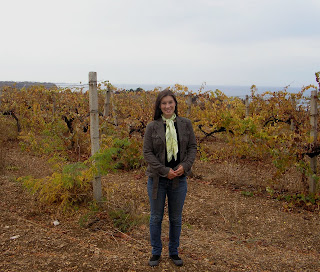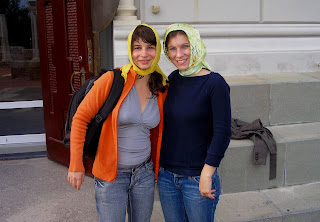To get to Sevastopol I took the train. The train was old fashioned and slow; it took almost two hours. Upon arrival in Sevastopol we set about being tourist. Here is Agi (Hungary), Anita (Poland) and Matthias (Germany) waiting to take the bus from our hotel to the city.


Our hotel was quite a distance from the city centre. We had two transportation options: a thirty minute bus ride around the bay or a ten minute boat ride across the bay. We took the boat! On our quick boat ride we saw many navy ships. The picture below on the right shows the Ukrainian (left) and Russian (right) flags.



Our boat ride brought us directly to the city centre to a square named after Crimea war hero, Admiral Nakihmov. We were greeted by some of Eugene's friends who were kind enough to be our tour guides for the day.


Because we arrived on a Saturday there were wedding parties everywhere. This phenomenon happens in Simferopol as well. When people are married here they are not married in a church, but rather in a civil ceremony. This is because according to the Orthodox church, once married, your souls are united forever. It seems people are not willing to take that risk and prefer to opt for a civil ceremony. Because of this, the administrative area of the city, usually located in the city centre, is always flooded with bridges and grooms on Friday and Saturday. Moreover, it is tradition to visit war monuments after the wedding ceremony and these are also primarily located in the city centre.

Sevastopol is full of war monuments because it was a strategic city for three wars: the Crimean War, WWI and WWII. The photo below on the right is part of a row of identical monuments that showcases cities which showed courage during the wars. The one I am standing next to says Sevastopol. We also watched the changing of the guards done by cadets.



After visiting the war monuments we took a stroll along the water front.


We eventually made our way to Balaklava, a part of Sevastopol which was home to a functioning nuclear submarine base until 1993. Below is a map of the base. The base is dug out from a mountain and is strong enough to withstand a nuclear holocaust. While functional, this base was top secret. Inside the base it was very cold and dark. It reminded me of something from a James Bond movie.


The picture below (left) is the area where they repaired submarines. This channel could only hold one submarine at a time. It took approximately one month to repair one submarine. Throughout the base there were several doors (below right). Each door weighed some ten tonnes.


This was once an entrance to a submarine; if functional, it would be vertical.

After visiting the base we took a boat to the main stretch of Balaklava. Below right is a picture of our boat driver. Below left is a picture from the boat. Do you see the towers on top of the hill? These were Italian look out towers. They are very old, though I forget which year they were constructed.


We walked up the hill to get a better view and see the towers.


Below is Balaklava. The mountain in the picture to the left of the water is the nuclear base.

Here is the Black Sea! I find the Black Sea very interesting. It can only sustain life in the top layer of water. The top layer does not mix with the deeper layer because they are different densities. I've asked a few people why the Black Sea is black and they've said that it is because the bottom layer is full of sulfur. However, I have yet to find this information in English on the internet.


During our second day of traveling around Sevastopol we decided to go to Chersonesos (I kept pronouncing it Hear-son-esque) to see ancient Greek ruins. While waiting for the bus I took the picture below. Crimea is well known for its wine and you see vineyards everywhere.

Here are the Greek ruins. They were beautiful! I didn't think that I would be able to touch them, but not only could I touch them, I could walk all over them too. It was very realistic, the complete opposite of a museum.




Here is a group shot of us on top of the ruins. Left to right: Ben (Germany), Matthias (Germany), Agi (Hungary), and me.

Among the ruins is St. Vladimir's Cathedral. The gazebo like structure that you see below is where Vladimir the Great was baptized Orthodox in 988 so that he could marry a Greek princess. This event marked the beginning of the Orthodox Church in what is today Russia and post-Soviet countries.




Here again is St. Vladimir's Cathedral. You may have wondered why in all my photographs I am wearing a scarf. I wore a scarf all weekend for two reasons: 1) I think my scarf is pretty, and 2) women must cover their heads if they wish to enter an Orthodox church. Because I had my scarf I could go inside, but I was unable to take photographs inside. The interior was stunning - a mix between Christian stories and figures and Islamic colors and details.


After a long day of traveling I bought a corn-on-the-cob, a common snack sold by old women on the streets, and sat by the Black Sea. I had a great time in Sevastopol!

No comments:
Post a Comment